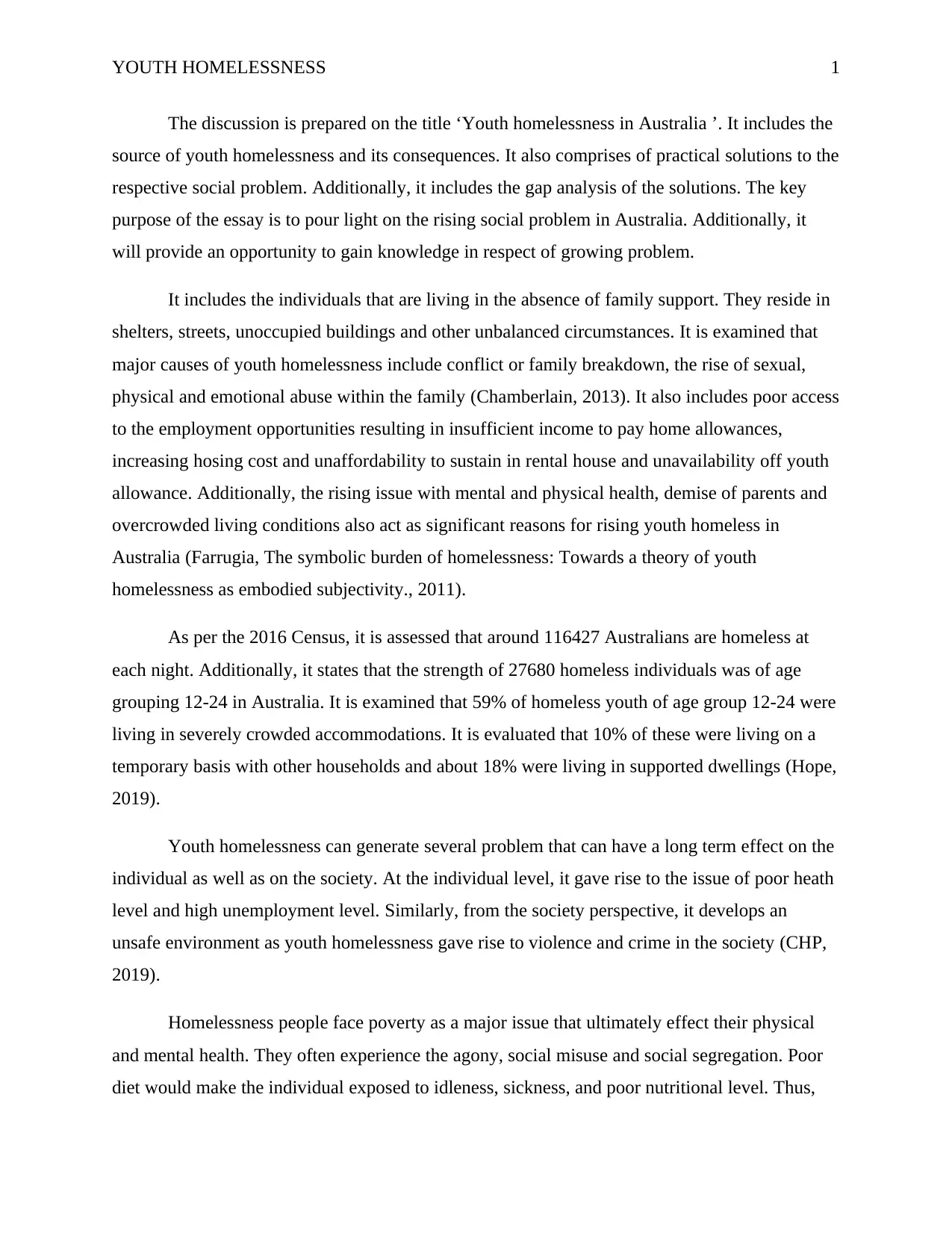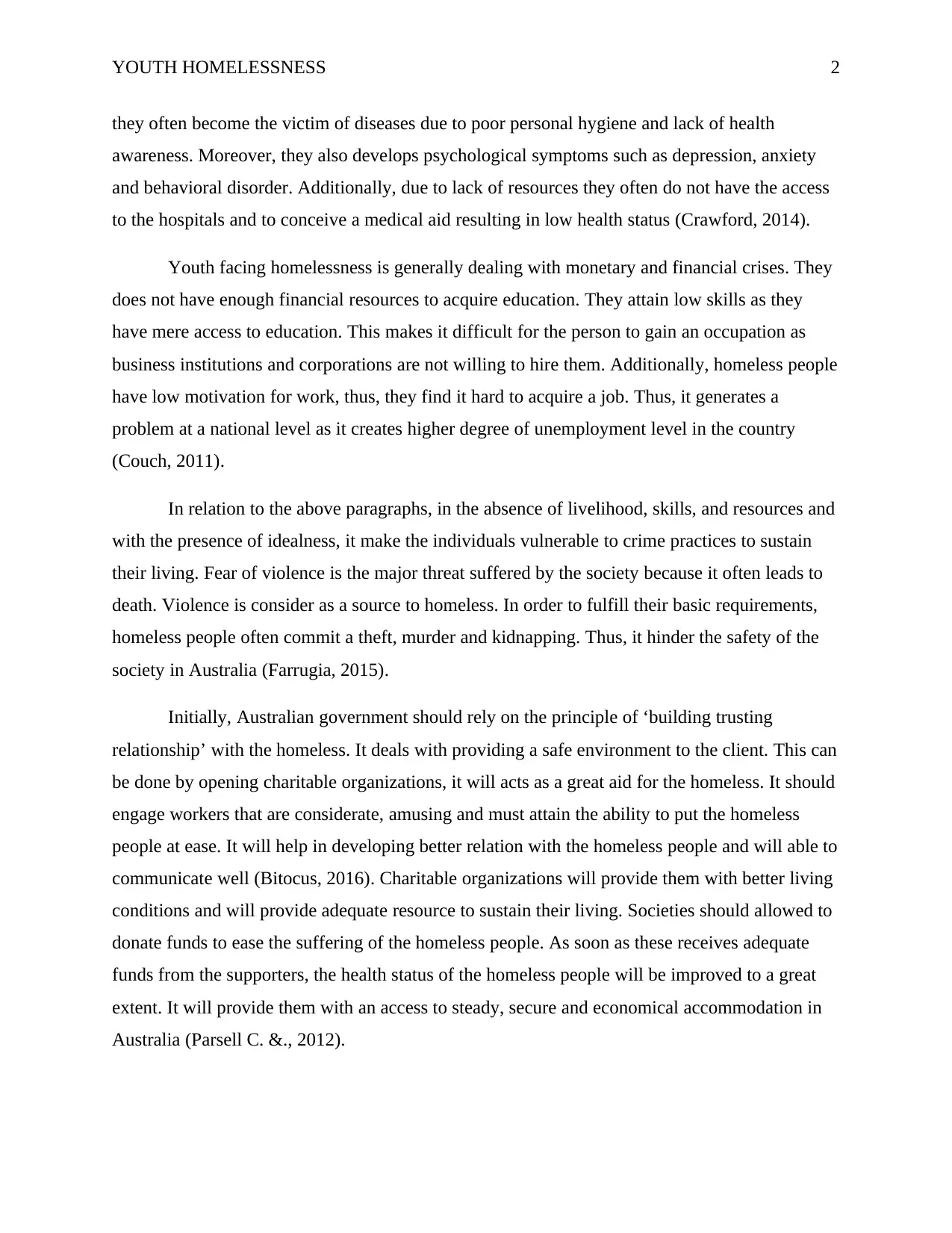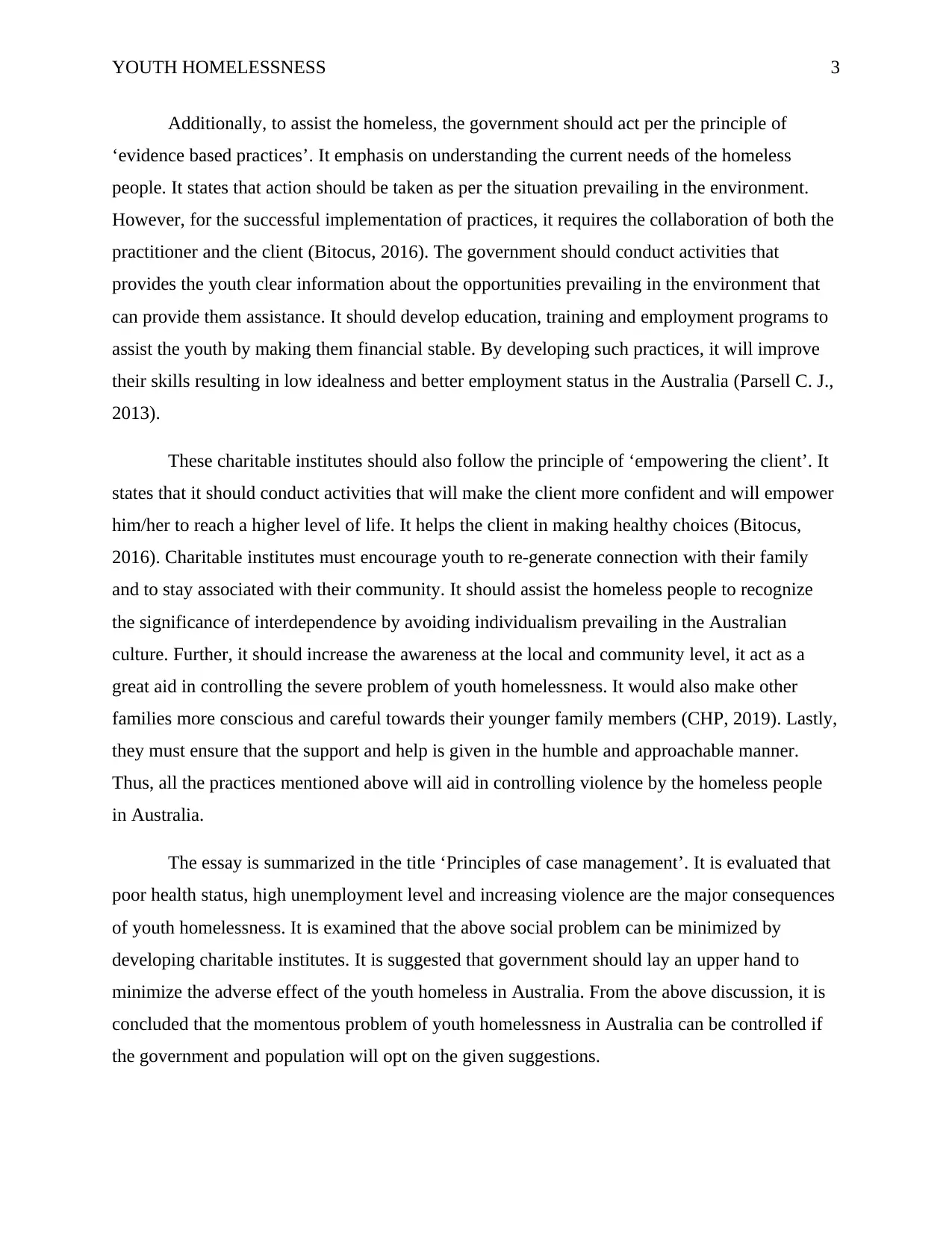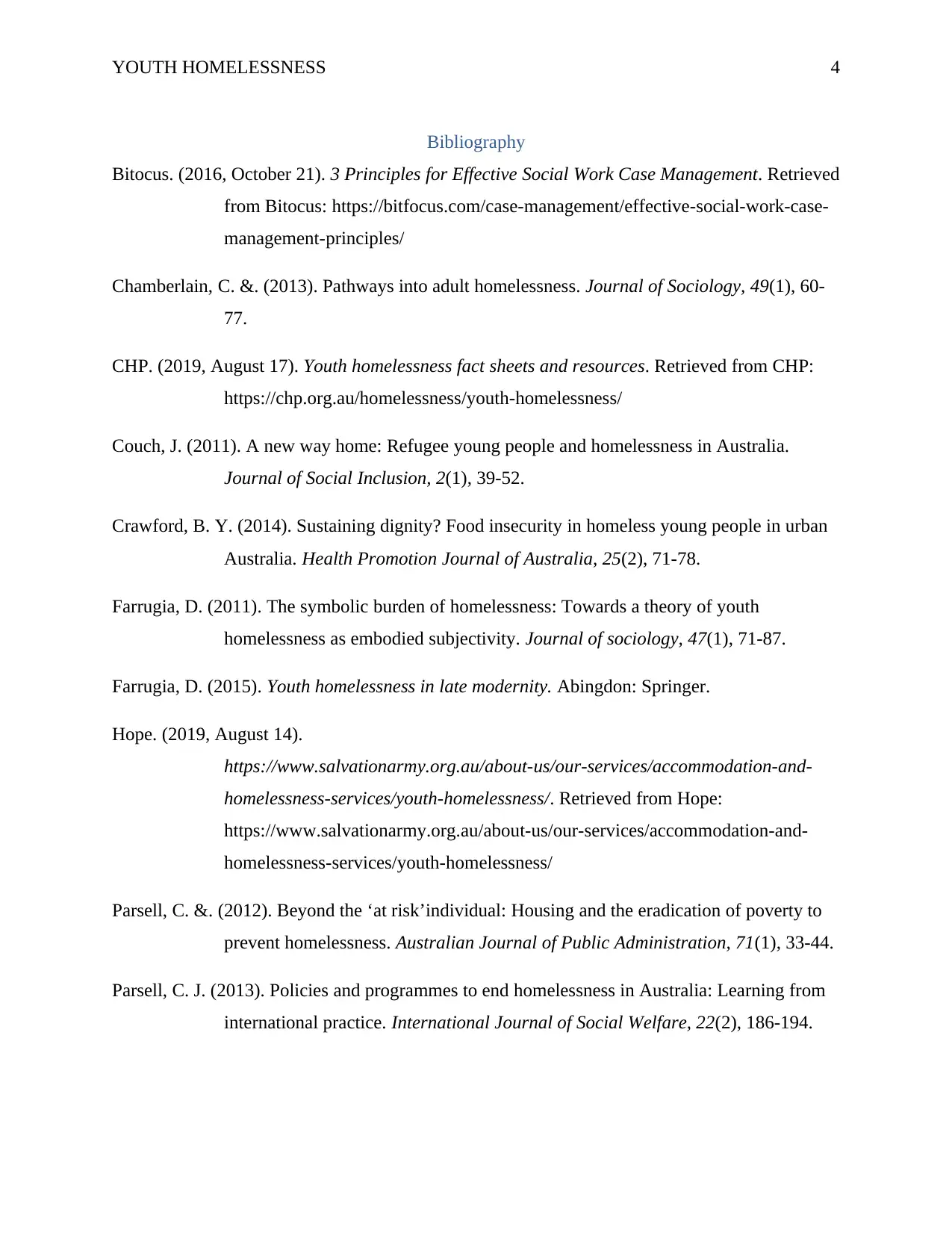Youth Homelessness Discussion 2022
VerifiedAdded on 2022/09/28
|6
|1631
|23
AI Summary
Contribute Materials
Your contribution can guide someone’s learning journey. Share your
documents today.

RUNNING HEAD: YOUTH HOMELESSNESS
Principles of Case Management
Principles of Case Management
Secure Best Marks with AI Grader
Need help grading? Try our AI Grader for instant feedback on your assignments.

YOUTH HOMELESSNESS 1
The discussion is prepared on the title ‘Youth homelessness in Australia ’. It includes the
source of youth homelessness and its consequences. It also comprises of practical solutions to the
respective social problem. Additionally, it includes the gap analysis of the solutions. The key
purpose of the essay is to pour light on the rising social problem in Australia. Additionally, it
will provide an opportunity to gain knowledge in respect of growing problem.
It includes the individuals that are living in the absence of family support. They reside in
shelters, streets, unoccupied buildings and other unbalanced circumstances. It is examined that
major causes of youth homelessness include conflict or family breakdown, the rise of sexual,
physical and emotional abuse within the family (Chamberlain, 2013). It also includes poor access
to the employment opportunities resulting in insufficient income to pay home allowances,
increasing hosing cost and unaffordability to sustain in rental house and unavailability off youth
allowance. Additionally, the rising issue with mental and physical health, demise of parents and
overcrowded living conditions also act as significant reasons for rising youth homeless in
Australia (Farrugia, The symbolic burden of homelessness: Towards a theory of youth
homelessness as embodied subjectivity., 2011).
As per the 2016 Census, it is assessed that around 116427 Australians are homeless at
each night. Additionally, it states that the strength of 27680 homeless individuals was of age
grouping 12-24 in Australia. It is examined that 59% of homeless youth of age group 12-24 were
living in severely crowded accommodations. It is evaluated that 10% of these were living on a
temporary basis with other households and about 18% were living in supported dwellings (Hope,
2019).
Youth homelessness can generate several problem that can have a long term effect on the
individual as well as on the society. At the individual level, it gave rise to the issue of poor heath
level and high unemployment level. Similarly, from the society perspective, it develops an
unsafe environment as youth homelessness gave rise to violence and crime in the society (CHP,
2019).
Homelessness people face poverty as a major issue that ultimately effect their physical
and mental health. They often experience the agony, social misuse and social segregation. Poor
diet would make the individual exposed to idleness, sickness, and poor nutritional level. Thus,
The discussion is prepared on the title ‘Youth homelessness in Australia ’. It includes the
source of youth homelessness and its consequences. It also comprises of practical solutions to the
respective social problem. Additionally, it includes the gap analysis of the solutions. The key
purpose of the essay is to pour light on the rising social problem in Australia. Additionally, it
will provide an opportunity to gain knowledge in respect of growing problem.
It includes the individuals that are living in the absence of family support. They reside in
shelters, streets, unoccupied buildings and other unbalanced circumstances. It is examined that
major causes of youth homelessness include conflict or family breakdown, the rise of sexual,
physical and emotional abuse within the family (Chamberlain, 2013). It also includes poor access
to the employment opportunities resulting in insufficient income to pay home allowances,
increasing hosing cost and unaffordability to sustain in rental house and unavailability off youth
allowance. Additionally, the rising issue with mental and physical health, demise of parents and
overcrowded living conditions also act as significant reasons for rising youth homeless in
Australia (Farrugia, The symbolic burden of homelessness: Towards a theory of youth
homelessness as embodied subjectivity., 2011).
As per the 2016 Census, it is assessed that around 116427 Australians are homeless at
each night. Additionally, it states that the strength of 27680 homeless individuals was of age
grouping 12-24 in Australia. It is examined that 59% of homeless youth of age group 12-24 were
living in severely crowded accommodations. It is evaluated that 10% of these were living on a
temporary basis with other households and about 18% were living in supported dwellings (Hope,
2019).
Youth homelessness can generate several problem that can have a long term effect on the
individual as well as on the society. At the individual level, it gave rise to the issue of poor heath
level and high unemployment level. Similarly, from the society perspective, it develops an
unsafe environment as youth homelessness gave rise to violence and crime in the society (CHP,
2019).
Homelessness people face poverty as a major issue that ultimately effect their physical
and mental health. They often experience the agony, social misuse and social segregation. Poor
diet would make the individual exposed to idleness, sickness, and poor nutritional level. Thus,

YOUTH HOMELESSNESS 2
they often become the victim of diseases due to poor personal hygiene and lack of health
awareness. Moreover, they also develops psychological symptoms such as depression, anxiety
and behavioral disorder. Additionally, due to lack of resources they often do not have the access
to the hospitals and to conceive a medical aid resulting in low health status (Crawford, 2014).
Youth facing homelessness is generally dealing with monetary and financial crises. They
does not have enough financial resources to acquire education. They attain low skills as they
have mere access to education. This makes it difficult for the person to gain an occupation as
business institutions and corporations are not willing to hire them. Additionally, homeless people
have low motivation for work, thus, they find it hard to acquire a job. Thus, it generates a
problem at a national level as it creates higher degree of unemployment level in the country
(Couch, 2011).
In relation to the above paragraphs, in the absence of livelihood, skills, and resources and
with the presence of idealness, it make the individuals vulnerable to crime practices to sustain
their living. Fear of violence is the major threat suffered by the society because it often leads to
death. Violence is consider as a source to homeless. In order to fulfill their basic requirements,
homeless people often commit a theft, murder and kidnapping. Thus, it hinder the safety of the
society in Australia (Farrugia, 2015).
Initially, Australian government should rely on the principle of ‘building trusting
relationship’ with the homeless. It deals with providing a safe environment to the client. This can
be done by opening charitable organizations, it will acts as a great aid for the homeless. It should
engage workers that are considerate, amusing and must attain the ability to put the homeless
people at ease. It will help in developing better relation with the homeless people and will able to
communicate well (Bitocus, 2016). Charitable organizations will provide them with better living
conditions and will provide adequate resource to sustain their living. Societies should allowed to
donate funds to ease the suffering of the homeless people. As soon as these receives adequate
funds from the supporters, the health status of the homeless people will be improved to a great
extent. It will provide them with an access to steady, secure and economical accommodation in
Australia (Parsell C. &., 2012).
they often become the victim of diseases due to poor personal hygiene and lack of health
awareness. Moreover, they also develops psychological symptoms such as depression, anxiety
and behavioral disorder. Additionally, due to lack of resources they often do not have the access
to the hospitals and to conceive a medical aid resulting in low health status (Crawford, 2014).
Youth facing homelessness is generally dealing with monetary and financial crises. They
does not have enough financial resources to acquire education. They attain low skills as they
have mere access to education. This makes it difficult for the person to gain an occupation as
business institutions and corporations are not willing to hire them. Additionally, homeless people
have low motivation for work, thus, they find it hard to acquire a job. Thus, it generates a
problem at a national level as it creates higher degree of unemployment level in the country
(Couch, 2011).
In relation to the above paragraphs, in the absence of livelihood, skills, and resources and
with the presence of idealness, it make the individuals vulnerable to crime practices to sustain
their living. Fear of violence is the major threat suffered by the society because it often leads to
death. Violence is consider as a source to homeless. In order to fulfill their basic requirements,
homeless people often commit a theft, murder and kidnapping. Thus, it hinder the safety of the
society in Australia (Farrugia, 2015).
Initially, Australian government should rely on the principle of ‘building trusting
relationship’ with the homeless. It deals with providing a safe environment to the client. This can
be done by opening charitable organizations, it will acts as a great aid for the homeless. It should
engage workers that are considerate, amusing and must attain the ability to put the homeless
people at ease. It will help in developing better relation with the homeless people and will able to
communicate well (Bitocus, 2016). Charitable organizations will provide them with better living
conditions and will provide adequate resource to sustain their living. Societies should allowed to
donate funds to ease the suffering of the homeless people. As soon as these receives adequate
funds from the supporters, the health status of the homeless people will be improved to a great
extent. It will provide them with an access to steady, secure and economical accommodation in
Australia (Parsell C. &., 2012).

YOUTH HOMELESSNESS 3
Additionally, to assist the homeless, the government should act per the principle of
‘evidence based practices’. It emphasis on understanding the current needs of the homeless
people. It states that action should be taken as per the situation prevailing in the environment.
However, for the successful implementation of practices, it requires the collaboration of both the
practitioner and the client (Bitocus, 2016). The government should conduct activities that
provides the youth clear information about the opportunities prevailing in the environment that
can provide them assistance. It should develop education, training and employment programs to
assist the youth by making them financial stable. By developing such practices, it will improve
their skills resulting in low idealness and better employment status in the Australia (Parsell C. J.,
2013).
These charitable institutes should also follow the principle of ‘empowering the client’. It
states that it should conduct activities that will make the client more confident and will empower
him/her to reach a higher level of life. It helps the client in making healthy choices (Bitocus,
2016). Charitable institutes must encourage youth to re-generate connection with their family
and to stay associated with their community. It should assist the homeless people to recognize
the significance of interdependence by avoiding individualism prevailing in the Australian
culture. Further, it should increase the awareness at the local and community level, it act as a
great aid in controlling the severe problem of youth homelessness. It would also make other
families more conscious and careful towards their younger family members (CHP, 2019). Lastly,
they must ensure that the support and help is given in the humble and approachable manner.
Thus, all the practices mentioned above will aid in controlling violence by the homeless people
in Australia.
The essay is summarized in the title ‘Principles of case management’. It is evaluated that
poor health status, high unemployment level and increasing violence are the major consequences
of youth homelessness. It is examined that the above social problem can be minimized by
developing charitable institutes. It is suggested that government should lay an upper hand to
minimize the adverse effect of the youth homeless in Australia. From the above discussion, it is
concluded that the momentous problem of youth homelessness in Australia can be controlled if
the government and population will opt on the given suggestions.
Additionally, to assist the homeless, the government should act per the principle of
‘evidence based practices’. It emphasis on understanding the current needs of the homeless
people. It states that action should be taken as per the situation prevailing in the environment.
However, for the successful implementation of practices, it requires the collaboration of both the
practitioner and the client (Bitocus, 2016). The government should conduct activities that
provides the youth clear information about the opportunities prevailing in the environment that
can provide them assistance. It should develop education, training and employment programs to
assist the youth by making them financial stable. By developing such practices, it will improve
their skills resulting in low idealness and better employment status in the Australia (Parsell C. J.,
2013).
These charitable institutes should also follow the principle of ‘empowering the client’. It
states that it should conduct activities that will make the client more confident and will empower
him/her to reach a higher level of life. It helps the client in making healthy choices (Bitocus,
2016). Charitable institutes must encourage youth to re-generate connection with their family
and to stay associated with their community. It should assist the homeless people to recognize
the significance of interdependence by avoiding individualism prevailing in the Australian
culture. Further, it should increase the awareness at the local and community level, it act as a
great aid in controlling the severe problem of youth homelessness. It would also make other
families more conscious and careful towards their younger family members (CHP, 2019). Lastly,
they must ensure that the support and help is given in the humble and approachable manner.
Thus, all the practices mentioned above will aid in controlling violence by the homeless people
in Australia.
The essay is summarized in the title ‘Principles of case management’. It is evaluated that
poor health status, high unemployment level and increasing violence are the major consequences
of youth homelessness. It is examined that the above social problem can be minimized by
developing charitable institutes. It is suggested that government should lay an upper hand to
minimize the adverse effect of the youth homeless in Australia. From the above discussion, it is
concluded that the momentous problem of youth homelessness in Australia can be controlled if
the government and population will opt on the given suggestions.
Secure Best Marks with AI Grader
Need help grading? Try our AI Grader for instant feedback on your assignments.

YOUTH HOMELESSNESS 4
Bibliography
Bitocus. (2016, October 21). 3 Principles for Effective Social Work Case Management. Retrieved
from Bitocus: https://bitfocus.com/case-management/effective-social-work-case-
management-principles/
Chamberlain, C. &. (2013). Pathways into adult homelessness. Journal of Sociology, 49(1), 60-
77.
CHP. (2019, August 17). Youth homelessness fact sheets and resources. Retrieved from CHP:
https://chp.org.au/homelessness/youth-homelessness/
Couch, J. (2011). A new way home: Refugee young people and homelessness in Australia.
Journal of Social Inclusion, 2(1), 39-52.
Crawford, B. Y. (2014). Sustaining dignity? Food insecurity in homeless young people in urban
Australia. Health Promotion Journal of Australia, 25(2), 71-78.
Farrugia, D. (2011). The symbolic burden of homelessness: Towards a theory of youth
homelessness as embodied subjectivity. Journal of sociology, 47(1), 71-87.
Farrugia, D. (2015). Youth homelessness in late modernity. Abingdon: Springer.
Hope. (2019, August 14).
https://www.salvationarmy.org.au/about-us/our-services/accommodation-and-
homelessness-services/youth-homelessness/. Retrieved from Hope:
https://www.salvationarmy.org.au/about-us/our-services/accommodation-and-
homelessness-services/youth-homelessness/
Parsell, C. &. (2012). Beyond the ‘at risk’individual: Housing and the eradication of poverty to
prevent homelessness. Australian Journal of Public Administration, 71(1), 33-44.
Parsell, C. J. (2013). Policies and programmes to end homelessness in Australia: Learning from
international practice. International Journal of Social Welfare, 22(2), 186-194.
Bibliography
Bitocus. (2016, October 21). 3 Principles for Effective Social Work Case Management. Retrieved
from Bitocus: https://bitfocus.com/case-management/effective-social-work-case-
management-principles/
Chamberlain, C. &. (2013). Pathways into adult homelessness. Journal of Sociology, 49(1), 60-
77.
CHP. (2019, August 17). Youth homelessness fact sheets and resources. Retrieved from CHP:
https://chp.org.au/homelessness/youth-homelessness/
Couch, J. (2011). A new way home: Refugee young people and homelessness in Australia.
Journal of Social Inclusion, 2(1), 39-52.
Crawford, B. Y. (2014). Sustaining dignity? Food insecurity in homeless young people in urban
Australia. Health Promotion Journal of Australia, 25(2), 71-78.
Farrugia, D. (2011). The symbolic burden of homelessness: Towards a theory of youth
homelessness as embodied subjectivity. Journal of sociology, 47(1), 71-87.
Farrugia, D. (2015). Youth homelessness in late modernity. Abingdon: Springer.
Hope. (2019, August 14).
https://www.salvationarmy.org.au/about-us/our-services/accommodation-and-
homelessness-services/youth-homelessness/. Retrieved from Hope:
https://www.salvationarmy.org.au/about-us/our-services/accommodation-and-
homelessness-services/youth-homelessness/
Parsell, C. &. (2012). Beyond the ‘at risk’individual: Housing and the eradication of poverty to
prevent homelessness. Australian Journal of Public Administration, 71(1), 33-44.
Parsell, C. J. (2013). Policies and programmes to end homelessness in Australia: Learning from
international practice. International Journal of Social Welfare, 22(2), 186-194.

YOUTH HOMELESSNESS 5
1 out of 6
Related Documents
Your All-in-One AI-Powered Toolkit for Academic Success.
+13062052269
info@desklib.com
Available 24*7 on WhatsApp / Email
![[object Object]](/_next/static/media/star-bottom.7253800d.svg)
Unlock your academic potential
© 2024 | Zucol Services PVT LTD | All rights reserved.





